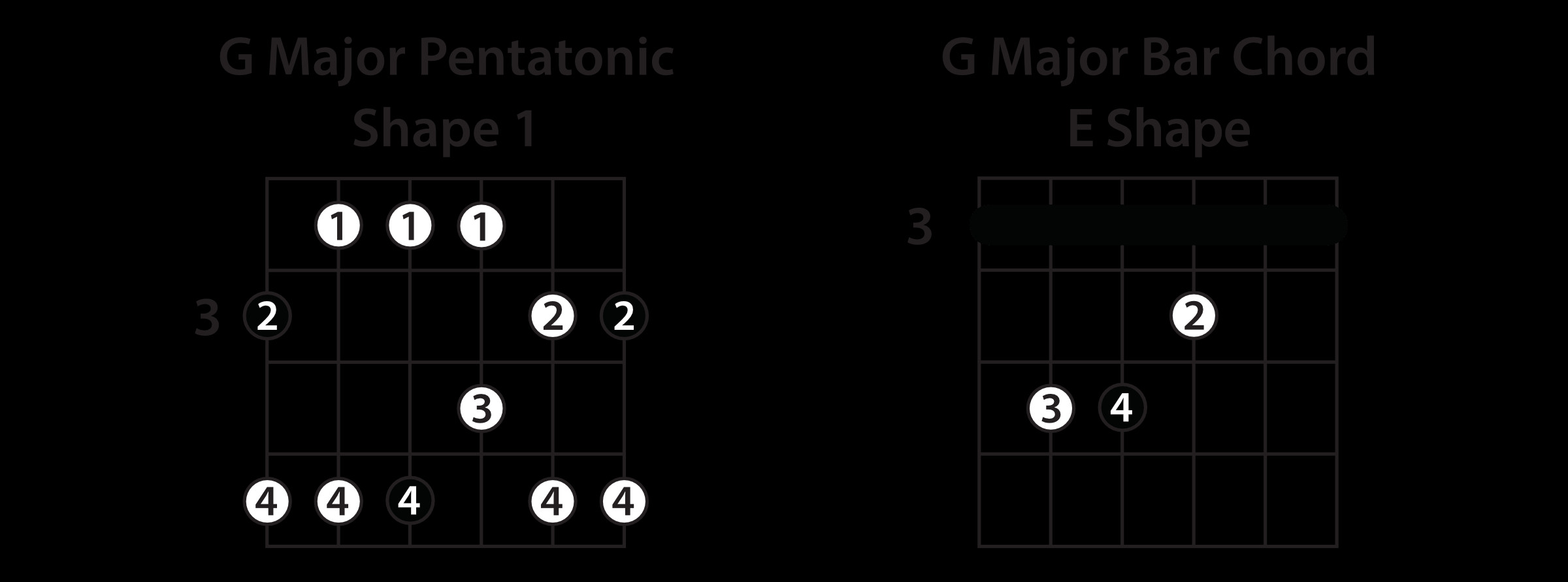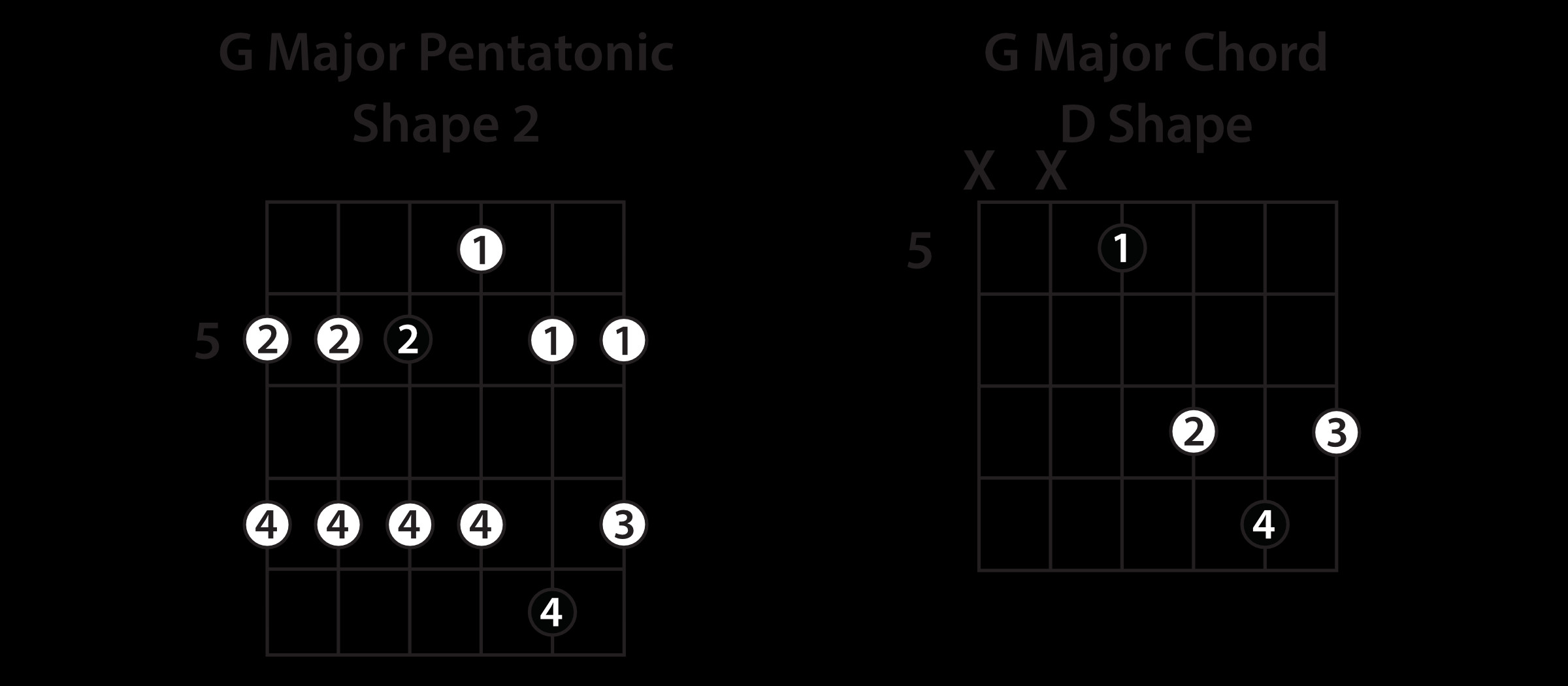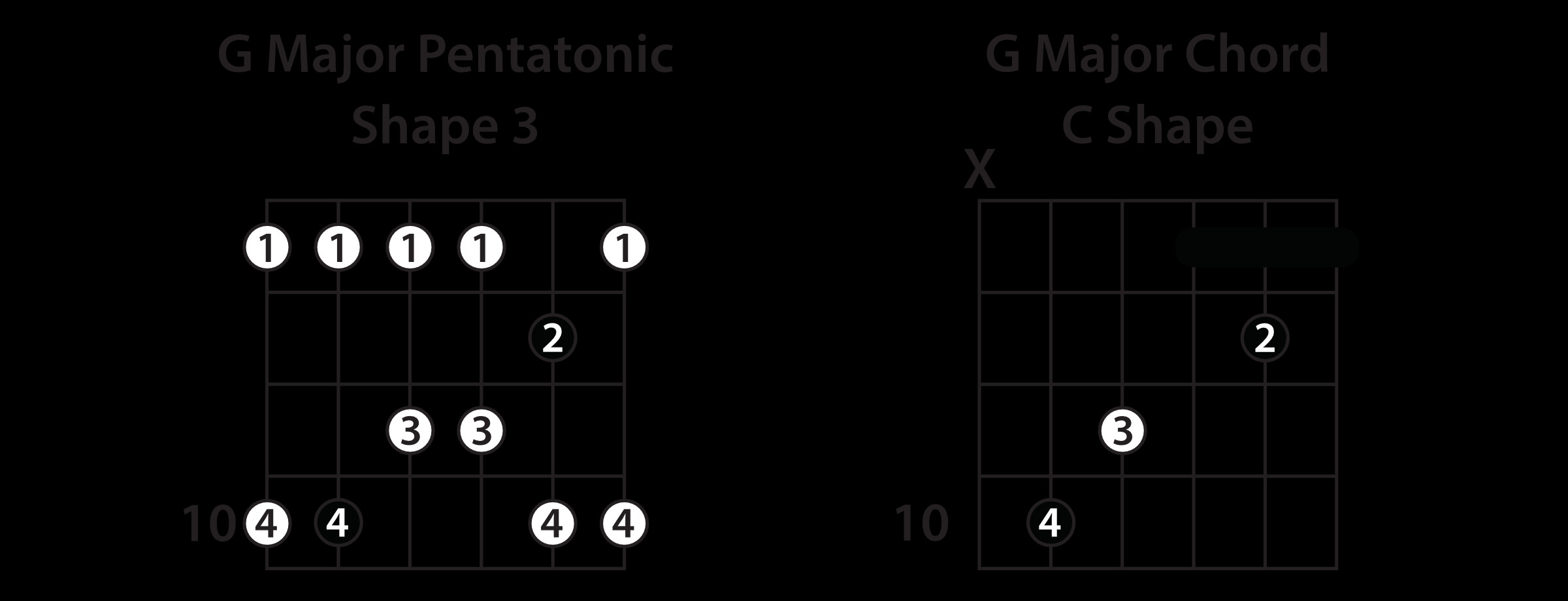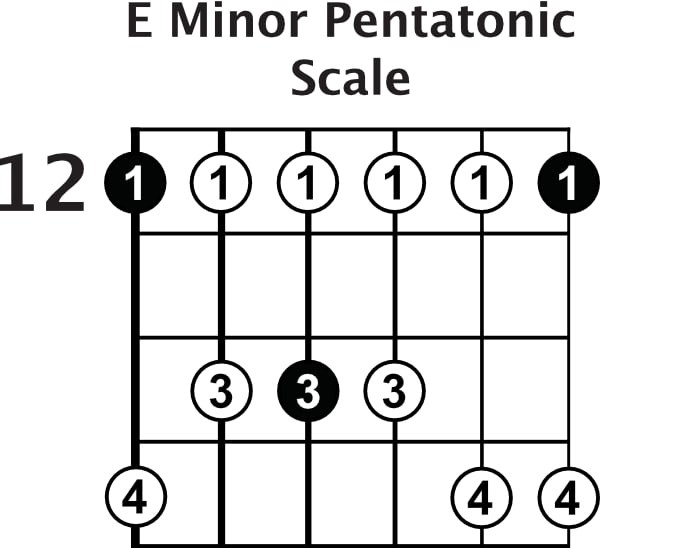Of all the guitar scales you’ll explore, the pentatonic scale is likely to become a cornerstone of your playing. This scale has provided the foundation for countless iconic guitar solos across genres and is an indispensable tool for guitarists looking to craft their own lead lines and improvisations.
The pentatonic scale, like many scales, originates from the major scale. The prefix “penta” signifies five, and as the name suggests, this scale is composed of just five notes. These five notes are derived from the major scale by omitting the fourth and seventh degrees.
By removing these two notes, we alter some of the more dissonant intervals present in the major scale, resulting in a scale that feels more open and versatile. This characteristic allows for greater freedom when improvising and soloing, reducing the concern of landing on a note that feels out of place.
What is a Pentatonic Scale?
To understand the pentatonic scale, it’s helpful to see how it’s derived from the major scale. Let’s take a look at the C major scale as an example:
C Major Scale: C – D – E – F – G – A – B – C
The notes in the C major scale are separated by intervals of whole and half steps, creating its characteristic bright sound. Now, to form the C major pentatonic scale, we remove the 4th and 7th notes of the major scale. In C major, these are F (4th) and B (7th).
C Major Pentatonic Scale: C – D – E – G – A – C
Notice how removing these notes creates a simpler, more open sound. This is the essence of the pentatonic scale – a five-note scale that is incredibly versatile and easy to use in various musical contexts. The absence of the 4th and 7th degrees gives the pentatonic scale a less defined, more ambiguous tonality compared to the full major scale, making it ideal for soloing and improvisation over a wide range of chords and progressions.
The Major Pentatonic Scale
There are two primary forms of the pentatonic scale: the major pentatonic and the minor pentatonic. We’ll begin by examining the major pentatonic scale.
The major pentatonic scale shape requires some finger dexterity as it utilizes all four fingers in varied patterns across the fretboard. It’s best to learn this shape string by string, starting slowly. Here is the diagram for a G major pentatonic scale:
 G Major Pentatonic Scale Shape
G Major Pentatonic Scale Shape
In these diagrams, the black circles denote the root notes of the scale. Root notes are fundamental as they give the scale its name. In this instance, the black circles represent G notes, indicating that this is a G major pentatonic scale.
Using the root notes (black circles) as your starting points, you can observe that the five notes of the scale are repeated across more than two octaves. This extended range allows for expressive melodic lines across the fretboard.
To help you practice and internalize this scale shape, it’s highly beneficial to play along with a backing track or jam track. This makes the process of learning scales more engaging and helps you develop your ear and timing.
The Minor Pentatonic Scale
The second essential pentatonic scale is the minor pentatonic. This scale shape is arguably the most frequently used pentatonic scale for guitar solos, especially in genres like blues, rock, and metal. Its popularity stems from its simplicity and effectiveness.
The minor pentatonic shape in its most common form uses just two repeating patterns across the six strings, making it remarkably easy to learn and memorize. Here is the diagram for the G minor pentatonic scale:
 G Minor Pentatonic Scale Shape
G Minor Pentatonic Scale Shape
As you can see, the minor pentatonic scale starts on the same root note position as the major pentatonic shape but uses a different finger pattern. While the G major pentatonic scale is derived from the key of G major, the G minor pentatonic scale is based on the key of G minor. These distinct tonal centers give each scale its unique character.
Just like with the major pentatonic scale, practicing the minor pentatonic scale with a jam track is highly recommended. Mastering both the major and minor pentatonic shapes is crucial before delving into more advanced pentatonic concepts.
Exploring the 5 Pentatonic Scale Shapes
By this point, you should be acquainted with two out of the five fundamental pentatonic scale shapes. These five shapes, when combined, cover a span of twelve frets before the patterns repeat in higher octaves, and they seamlessly connect to one another across the fretboard.
Think of these five shapes as puzzle pieces that, when put together, represent all possible positions to play the five notes of the pentatonic scale across the guitar neck within a 12-fret range.
Shape #1: The first shape is likely already familiar to you if you’ve learned the major pentatonic scale earlier in this guide. This shape, often referred to as position one, is based around an E major chord shape (in open position). If you overlay the scale diagram on top of the E major chord shape, you’ll notice how they align. The pentatonic scale incorporates all the notes of the E major chord and adds a few more from within the same key.
 Pentatonic Scale Shape 1
Pentatonic Scale Shape 1
Visualizing chord shapes within scale patterns is a valuable practice. It not only aids in memorizing scale shapes but also helps you identify the location of root notes and understand the harmonic context of the scale.
Shape #2: Shape #2 begins precisely where Shape #1 concludes, creating a continuous flow up the fretboard. Observe the root notes in this shape; you’ll see that the scale pattern effectively outlines a D major chord shape (in open position) when transposed up the neck to become part of a G major chord.
 Pentatonic Scale Shape 2
Pentatonic Scale Shape 2
As you progress through these shapes, pay close attention to the connection points between each consecutive shape. Developing the ability to seamlessly transition between these shapes is essential for fluid and dynamic soloing. Instead of being confined to a single shape, you’ll be able to navigate the fretboard with greater freedom.
Shape #3: Moving further up the fretboard, we encounter pentatonic Shape #3. This shape is structured around a C major chord shape (in open position), again transposed to fit within the G major context. Remember, despite the changing shapes, we are still playing the same five-note pentatonic scale, just in different octaves and positions on the neck. The G root notes (black circles) remain consistent, reinforcing that we are still in G major pentatonic.
 Pentatonic Scale Shape 3
Pentatonic Scale Shape 3
Shape #4: Shape #4 presents another easily memorizable pattern. It features only two finger patterns across the six strings and closely aligns with the A major barre chord shape. As with the previous shapes, take note of how Shape #4 connects with Shape #3. These connections are the pathways that allow you to move smoothly between positions while soloing.
Shape #5: You might be wondering where the minor pentatonic scale shape fits within this sequence of five shapes. The minor pentatonic shape is, in fact, the fifth and final shape in this interconnected system. You might notice that this Shape #5 diagram looks slightly different from the G minor pentatonic scale shape presented earlier, which started on the 3rd fret. This is because that earlier shape was specifically a G minor pentatonic scale. Shape #5 here, in the context of our G major pentatonic sequence, outlines a standard G major chord shape (barre chord form).
The Relationship Between Major and Minor Pentatonic Scales
If you have some familiarity with music theory, you might be aware of the relationship between major and minor keys. For those new to this concept, here’s a concise explanation.
Every major key has a corresponding relative minor key. This relative minor key shares the exact same seven notes as its relative major counterpart. To find the relative minor key of any major key, you simply identify the sixth note of the major scale. This sixth note becomes the root note of the relative minor key.
In the key of G major, the sixth note is E. Therefore, the relative minor key of G major is E minor. If you play an E minor scale, you will be using the same notes as the G major scale, just starting from a different root.
G Major Scale: G A B C D E F#
Sixth Note: E
E Minor Scale: E F# G A B C D
You can see that both scales contain the same notes. This also means they share the same set of chords. This is why we use the term “relative.” This relative major and minor relationship directly applies to pentatonic scales as well.
Therefore, the five G major pentatonic shapes you’ve learned are literally the same five shapes as the E minor pentatonic scale shapes. The only distinction is that when playing in E minor, you would consider the E notes as your root notes instead of the G notes.
Here’s an E minor pentatonic scale diagram, demonstrating that it uses the identical shape and fretboard location as the fifth G major pentatonic shape:
 E Minor Pentatonic Scale Shape
E Minor Pentatonic Scale Shape
When improvising or soloing using the minor pentatonic scale, it’s important to emphasize the root notes of the relative minor key (in this case, E) rather than the root notes of the major key (G). This means consciously targeting the E notes more prominently than the G notes in your lead lines and improvisations to establish the minor tonality.
Practicing the Pentatonic Scale
Now that you understand the shapes and the major/minor relationship, effective practice is key to integrating the pentatonic scale into your playing. Here are some practice tips:
- Jam Tracks: Utilize jam tracks in various keys and styles to practice applying the pentatonic scales in a musical context. The included jam tracks with this lesson are a great starting point.
- Visualize Chord Shapes: Continue to visualize the underlying chord shapes within the pentatonic scale patterns. This reinforces the connection between chords and scales and helps you understand how to target chord tones in your solos.
- Connect the Shapes: Practice transitioning smoothly between the five shapes. Focus on the overlapping notes at the edges of each shape to create seamless melodic runs across the fretboard.
- Apply to Songs: Analyze solos in your favorite songs and identify where the pentatonic scale is being used. Try to play along with these songs, focusing on using the pentatonic scale to improvise your own solos in the style of the song.
- Start Slowly: Begin practicing slowly and focus on accuracy and clean technique. Gradually increase your speed as you become more comfortable with the shapes and patterns.
Conclusion
This guide has provided you with a comprehensive understanding of the pentatonic scale on the guitar, covering both major and minor forms and the five essential shapes. You’ve learned how these shapes connect across the fretboard and how to relate them to chord shapes.
Mastering the pentatonic scale is a significant step in your lead guitar journey. It opens up a world of possibilities for improvisation and solo creation. Remember, this is just the beginning. There’s much more to explore in the realm of lead guitar, but the pentatonic scale will serve as a powerful and versatile foundation for your continued musical growth.
To further enhance your guitar skills and delve deeper into lead guitar techniques, consider exploring additional resources and lessons. Consistent practice and a dedication to learning will unlock your potential as a guitarist.
Want to improve your guitar skills even faster? Unlock our interactive practice tool and learn from the most inspiring teachers inside the Guitareo members’ area. Click the big green button below and start your 7-day free trial today:
TRY GUITAREO FOR 7 DAYS
SHARE THIS:
 Andrew Clarke Profile Picture
Andrew Clarke Profile Picture
